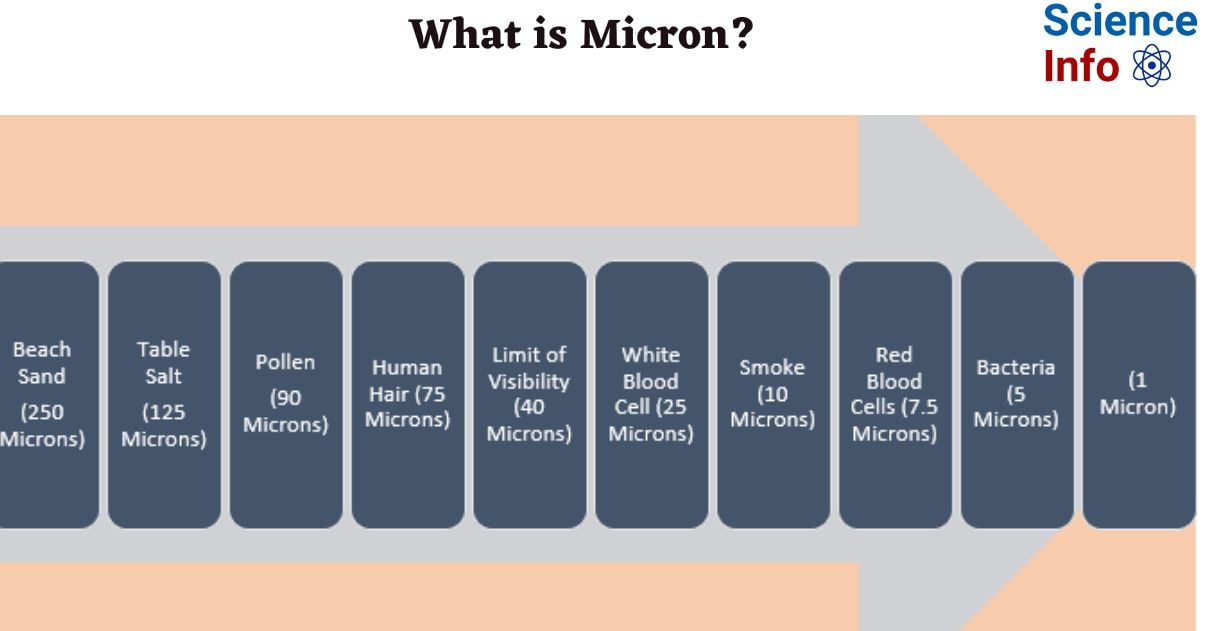Have you ever needed to measure anything so tiny that using millimeters or centimeters wouldn’t make sense? Microns come into play here. In the sciences and industry, a micron, often known as a micrometer/micrometer or µm, is a measuring unit. The micron is also known as a micrometer (American), micrometer (International Bureau of Weights and Measures), or by its abbreviation μm. Microns are usually expressed in the plural as “microns,” while the term “micra” was in use before 1950.

Interesting Science Videos
What is Micron?
A micron is one-millionth of a meter or one unit of length. One micron is equivalent to one μm, or 10-6 meters. The smallest object sizes are expressed in microns or micrometers. Things as small as one micron in diameter can only be seen with a microscope or other form of magnification; items as thick as ten microns are hardly visible at all.
What is the appearance of a millionth of a meter? Let’s begin with what is visible. A human hair’s diameter ranges from 70 microns to 210 microns, depending on the individual’s hair thickness.
Microns find application in numerous fields, including chemical engineering and biology, where they are used to quantify particle filtration and measure cell size, respectively. In computers, they are also employed to quantify the dimensions of various components, including integrated circuits. Furthermore, production specifications can specify that a product’s dimensions must be within a specified micron range to satisfy quality control requirements.
How Small is Micron?
A micron is a very small measuring unit. One micron is equivalent to 0.00003937 inches or 0.001 millimeters, for comparison.
Bacteria, which are normally this size, spider webs (3 to 8 microns wide), and raindrops (10 microns in diameter) are examples of objects in the 1 to 10 micron range.
We observe greater variances when we go beyond 10 microns. Human hair ranges in thickness from 17 to 181 microns, while wool fibers can be anywhere from 10 to 55 microns broad.
This dissection aids in understanding the microscopic world, where minute variations in size have a big impact.

Objects with Micron Size

| Object | Size (Microns) |
| Virus (e.g., influenza) | 0.02-0.3 |
| Dust particle | 0.5-5 |
| Human spermatozoa head | 5 |
| Spider silk thickness | 3-8 |
| Yeast cell | 3-5 |
| Bacterium | 1-10 |
| Mitochondria | 1-10 |
| Droplet of fog or water in a cloud | 10 |
| Fungus hyphae | 10 |
| Human red blood cell diameter | 10 |
| Plastic cling wrap thickness | 10-12 |
| Amoeba | 10-100 |
| Plant cell | 10-100 |
| Pollen grain | 10-100 |
| Eukaryotic cell | 10-100 |
| Nanoparticle (e.g., quantum dot) | <100 |
| Sheep wool fiber thickness | 10-55 |
| Soil particle | 20-200 |
| Human hair diameter | 17-181 |
| Sheet of paper thickness | 70-180 |
Why Micron Size Matters?
Microns are typically used to characterize airborne particles. In general, particles of dust and debris smaller than 25 microns can be seen by the human eye.
The degree of a particle’s possible hazard to human health can be inferred from its size.
The biggest health risk comes from particles between 0.3 and 0.9 microns since they are too big to be easily expelled and small enough to pass through the fine hairs lining our breathing passages. House and textile dust, pollen, pet dander, dust mites and their excrement, many germs, vehicle exhaust, mold spores, and particles from laser printers and copiers are some of these bothersome mid-range particles.
Mid-range particles are thought to be responsible for a variety of indoor air pollution-related health issues, including headaches, vertigo, cancer, and cardiovascular disease. This is because they have a higher likelihood of becoming embedded in lung tissue. Specifically, allergens and asthma episodes have been linked to dust mite particles, mold spores, pollen, and pet dander.
Even these tiny particles have the potential to irritate the lungs and breathing passageways, even though smaller particles (0.1 to 0.3 microns) are easier to breathe in and out of than mid-range particles. People who have cardiovascular illness, allergies, asthma, or other respiratory disorders can benefit most from smaller particle filtration.
| Particle | Size Range (microns) |
| Allergens | 0.1 – 0.3 |
| Dust Mites | 0.1 – 0.3 |
| Metal Fumes | 0.3 – 1 |
| Tobacco Smoke | 0.3 – 1 |
| Staphylococcus Bacteria | 0.3 – 1 |
| Mold Spores | Typically 0.3 |
Frequently Asked Questions (FAQs)
What is a Micron?
A micron is 0.000039 inches, or one-thousandth of a millimeter, as a unit of length. Microns are frequently used to quantify the size of microscopic things, including cells and bacteria.
How big is a micron?
A micron is equivalent to 0.001 mm, or 00003937 inches. A human hair’s diameter ranges from 70 microns to 210 microns, depending on the individual’s hair thickness. The usual length of a bacteria is 1–10 μm.
A spider web’s breadth is 3–8 μm, and a raindrop’s diameter is around 10 μm.
How many microns are in a mm?
1 micron (micrometre, µm) = 0.001 millimeters (mm) = 0.0001 centimeters (cm) = 0.000001 meter (m) = 3.9370079 x 10-5 inch and 1 inch = 25400 µm.
Video on Micron
References
- https://sciencenotes.org/what-is-a-micron-definition-and-examples/
- Helmenstine, Anne Marie, Ph.D. “Micron Definition.” ThoughtCo, Jan. 29, 2020, thoughtco.com/definition-of-micron-605346.
- https://www.durpro.com/blog/faq-5/what-is-a-micron-403
- https://www.thinmetalparts.com/how-big-is-a-micron/
- https://sierraolympia.com/what-is-a-micron/
- https://www.hepacart.com/blog/why-micron-size-matters-the-unseen-advantage-of-hepa-filtration
- https://www.breathingspace.co.uk/how-small-is-a-micron-and-why-does-it-matter-i67
- https://www.cummins.com/engines/what-micron

